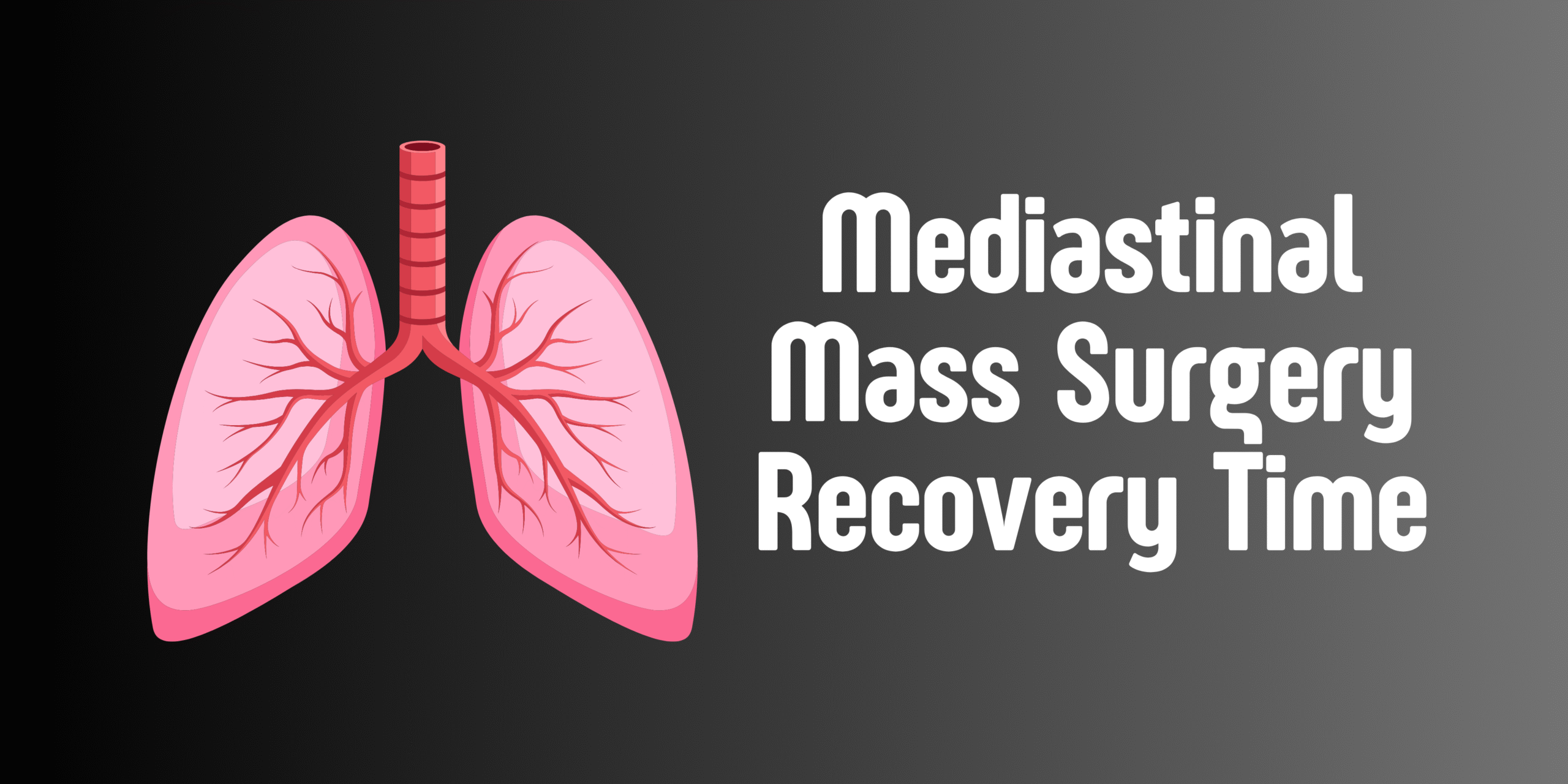A mediastinal mass is an abnormal growth that occurs in the mediastinum, the space between the lungs that contains crucial structures like the heart, trachea, and major blood vessels. These masses can be benign (non-cancerous) or malignant (cancerous) and may require surgical intervention for removal, depending on their size, location, and impact on surrounding organs. Mediastinal tumor treatment often involves surgery, especially if the mass is causing symptoms or has the potential to affect vital organs.
Surgery for mediastinal masses is a complex procedure, and the recovery time varies depending on multiple factors. This blog will explore the typical recovery process after mediastinal mass surgery, factors affecting recovery, and tips for ensuring a smooth recovery.
Understanding Mediastinal Mass Surgery
Before delving into recovery, it is essential to understand the type of surgery performed. The most common surgical procedures to remove a mediastinal mass are:
- Thoracotomy: A traditional approach involving a large incision in the chest. This method is often used for larger masses or those located deeper within the chest cavity.
- VATS (Video-Assisted Thoracic Surgery): A minimally invasive technique that uses smaller incisions and a camera to guide the surgeon. VATS is typically preferred for smaller masses or those easily accessible.
- Robotic-Assisted Surgery: An advanced minimally invasive technique that allows for greater precision and smaller incisions.
The choice of surgery depends on the location, size, and type of mass, along with the patient’s overall health condition.
Factors Affecting Recovery Time
Several factors influence how long it takes for a patient to recover after mediastinal mass surgery:
- Type of Surgery:
- Traditional thoracotomy generally requires a longer recovery time than minimally invasive surgeries like VATS or robotic-assisted surgery.
- Minimally invasive procedures typically result in smaller incisions, reduced pain, and quicker healing.
- Traditional thoracotomy generally requires a longer recovery time than minimally invasive surgeries like VATS or robotic-assisted surgery.
- Size and Location of the Mass:
- Larger masses or those near critical structures, such as the heart or major blood vessels, may require more extensive surgery and longer recovery times.
- A mass’s proximity to vital organs also impacts the difficulty of the surgery and the complexity of the post-operative care.
- Larger masses or those near critical structures, such as the heart or major blood vessels, may require more extensive surgery and longer recovery times.
- Patient’s Overall Health:
- A patient’s age, pre-existing health conditions (e.g., heart disease, diabetes), and lifestyle factors (e.g., smoking) can all affect how well they recover.
- Generally, younger, healthier individuals will recover more quickly than older individuals or those with multiple health issues.
- A patient’s age, pre-existing health conditions (e.g., heart disease, diabetes), and lifestyle factors (e.g., smoking) can all affect how well they recover.
- Post-Operative Complications:
- As with any surgery, complications like infections, bleeding, or pulmonary issues can extend recovery time.
- Patients with no complications generally experience a smoother recovery.
- As with any surgery, complications like infections, bleeding, or pulmonary issues can extend recovery time.
- Type of Mass (Benign vs. Malignant):
- Recovery time may vary depending on whether the mass is benign or malignant. While the surgery itself may be similar, additional treatments (e.g., chemotherapy or radiation) are required for malignant masses, which can prolong recovery.
Typical Recovery Timeline
While each patient is unique, here is a general recovery timeline after mediastinal mass surgery:
1. Hospital Stay (2-5 Days)
- First 24-48 Hours: After surgery, patients are typically monitored in the hospital. During this period, pain management is a primary focus. Many patients are given a PCA (patient-controlled analgesia) pump to manage pain. They may also have a chest tube placed to drain fluid or air from the chest cavity.
- Post-Surgery Care: Patients will begin breathing exercises, which are essential to prevent complications like pneumonia. Depending on the type of surgery, patients may also start moving around or sitting up to improve circulation.
2. Initial Recovery Phase (1-2 Weeks)
- First Week: For most patients, the first week after surgery involves rest and gradually increasing activity. By this point, most patients are able to discontinue the use of a PCA and transition to oral pain medications.
- Breathing and Physical Therapy: Gentle physical therapy may begin after a few days to help improve lung function and mobility. Patients are encouraged to avoid heavy lifting or intense physical exertion during this period.
3. Intermediate Recovery (3-6 Weeks)
- Post-Operative Appointments: After two to three weeks, patients will have follow-up appointments with their surgeon to ensure proper healing and monitor for complications.
- Return to Normal Activities: While patients are still not fully recovered, many start returning to light activities, including walking or short trips outside the house. However, more strenuous physical activities, such as lifting or exercise, are still avoided.
4. Full Recovery (2-6 Months)
- Healing Period: Most patients will take about 1-2 months to feel near-normal but may still experience some mild chest discomfort or fatigue. This is typical as the body continues healing from the surgery.
- Complete Recovery: Depending on the extent of the surgery and any complications, it can take anywhere from 2 to 6 months to fully recover. This period involves gradual improvements in strength, stamina, and the reduction of pain or discomfort.
Managing Recovery: Tips and Recommendations
- Pain Management:
- Pain is expected after surgery, but it should be manageable with prescribed medications. Over-the-counter medications like acetaminophen or ibuprofen may also be used for mild discomfort.
- Deep breathing exercises and relaxation techniques can help manage pain and prevent respiratory complications.
- Pain is expected after surgery, but it should be manageable with prescribed medications. Over-the-counter medications like acetaminophen or ibuprofen may also be used for mild discomfort.
- Physical Activity:
- While rest is important, gentle mobility, such as walking, is essential to improving circulation and preventing complications like blood clots.
- Follow your doctor’s guidelines on when to resume activities and what level of physical activity is safe.
- While rest is important, gentle mobility, such as walking, is essential to improving circulation and preventing complications like blood clots.
- Monitor for Complications:
- Signs of infection (fever, redness, swelling), shortness of breath, or chest pain should be immediately reported to your healthcare provider.
- Keep a close eye on the surgical site for any changes that could indicate complications.
- Signs of infection (fever, redness, swelling), shortness of breath, or chest pain should be immediately reported to your healthcare provider.
- Follow-Up Appointments:
- Attend all scheduled follow-up appointments with your surgeon to monitor your healing and check for any signs of recurrence (if the mass was malignant).
- Imaging tests like chest X-rays or CT scans may be necessary to confirm that the mass has been entirely removed.
- Attend all scheduled follow-up appointments with your surgeon to monitor your healing and check for any signs of recurrence (if the mass was malignant).
- Nutrition and Hydration:
- Proper nutrition and hydration are critical during the recovery process. A healthy diet rich in protein, vitamins, and minerals helps to promote healing.
- Your healthcare provider may recommend specific supplements or dietary changes to assist in recovery.
- Proper nutrition and hydration are critical during the recovery process. A healthy diet rich in protein, vitamins, and minerals helps to promote healing.
Conclusion
The recovery time after mediastinal mass surgery varies depending on the type of surgery, the patient’s overall health, and the complexity of the procedure. While it typically takes several weeks to return to normal activities, complete recovery may take several months. By following your doctor’s instructions for pain management, physical activity, and post-operative care, you can ensure a smooth and successful recovery process.
If you or a loved one is preparing for mediastinal mass surgery, it’s essential to communicate openly with your healthcare team and seek support as you navigate the recovery journey. While the process may feel daunting, with the right care and attention, full recovery is absolutely achievable.



